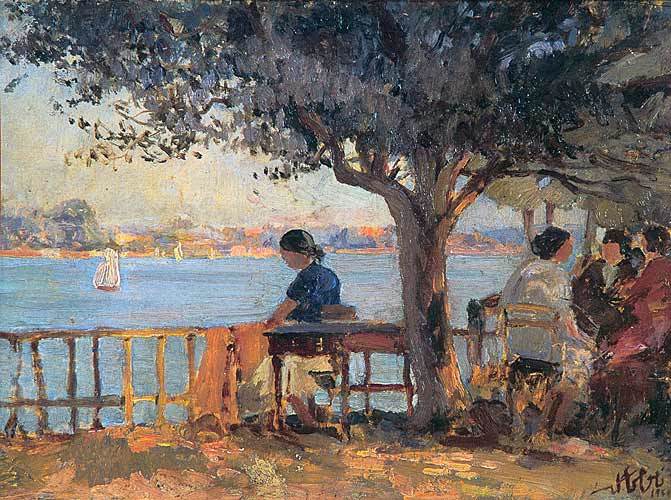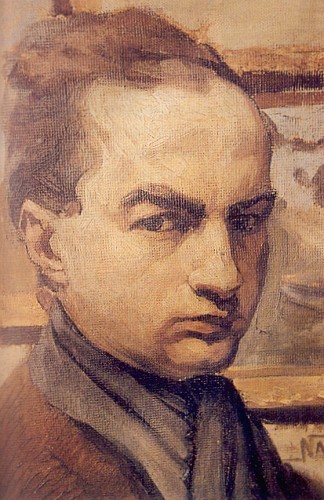Painter, intellectual, and politician (B. 1890, Samsun – D. August 30th, 1935, Kadıköy / Istanbul). Born to a Circassian family named Zeşo (Zecsu) who had been exiled from the Vubıh (Sochi) area of Caucasus, he was the son of İsmail Bey, the principal clerk of Tophane cashier’s office. He had his primary education at Sainte Pulcherie French School, his secondary education at Saint-Benoît French Secondary School and Galatasaray High School. His ability to paint emerged in those years. He painted his first oil painting for Dugumko Berzeg Bekir Pasha, one of the well-known district governors of that time, and in return, he was given a foal as a gift. Between 1911 and 1914, Namık İsmail developed his artistic sills by studying painting at Académie Julian and Fernand Cormon’s painting studio, in Paris. When the World War I (1914 – 1918) broke out, he returned to Istanbul and joined the Caucasus Campaign as a reserve officer. After he caught typhus in the battlefield, he had to return to Istanbul in 1917.
At the painting studio established
by the Ministry of War, he drew pictures related to war together with the other
painters. Because the armistice was signed when he was in Berlin, where he went
in order to exhibit those paintings, he did not get back to Istanbul and
studied painting at the painting studios of Lovis Corinth and Max Liebermann. There,
coming under the influence of the socialist movement led by the Spartacists, he
started publishing a periodical named “Kurtuluş”
together with some Turkish youngsters. This periodical continued being
published even after Namık İsmail returned to Istanbul in 1919. He wrote
articles and published some drawings for this periodical. In the same year, he
and his friends formed the Turkish Workers and Peasants Socialist Party, and he
undertook the task of being the party leader for a time. In the meantime, while
he was working as an art teacher at Gaziosman Paşa School, he also continued
giving art and French lessons for free at Circassian School in Beşiktaş.
For a while, he lived in Italy where
he went after he had gotten married. When he returned to Turkey, he worked in “İleri” newspaper, which was published in
Istanbul, as a painter and editor. In 1922, in Paris, winning a competition
that he entered, he illustrated the novel “Les Desenchantee” (Unhappy
Women) by Pierre Loti. When he came back to Turkey, he was first entrusted with
the task of being supervisor in charge of supervising art education in 1926,
then being the principal of Sanayi-i Nefise Mektebi (today’s Mimar Sinan Fine
Arts University) in 1927 by the Ministry of Education, and he maintained this
duty until he died.
Namık İsmail, one of the well-known
and amazing painters, was also a reputable Caucasian patriot. He actively
participated in the Circassian organizations such as the North Caucasian
Community, the Community of North Caucasian Immigrants in Turkey, the Caucasus
Liberty Committee, and he carried out various studies for the sake of those
organizations in Istanbul and Berlin. Apart from that, he was an intellectual
who had sympathy for the socialist thoughts, a journalist, and a writer.
His works of art were mostly in
impressionistic style. He succeeded in especially creating still life
paintings, like his known flower paintings. His works were always appreciated
in the art exhibitions in Ankara and Istanbul. Among the paintings that were
created by the Turkish painters by the order of the government in the World War
I (1914 – 1918) years and exhibited in Berlin and Vienna, there were five
paintings of him, four of which were oil paintings and one of which was a pastel
painting. Those paintings showing the actions and scenery related to the war
are now in State Art and Sculpture Museum. In this museum, there is also a
painting of him titled “Tefekkür” which
was taken from the exhibition held by Namık İsmail in Galatasaraylılar Yurdu.
Namık İsmail, who had been very
interested in literature since his youth, wrote many articles and stories
related to fine arts and popular issues, and created drawings, in the
newspapers and periodicals like Dergâh, Yeni Mecmua, Kurtuluş, İleri, Akşam.
Thanks to him, in
order to support the participation in arts and protect the artists, the first
legislative proposal consisting of placing the works of plastic arts, such as
painting and sculpture, in the state buildings, was offered. “Güzel Sanatların
Memleketimizde İnkişafına Dair Proje ve Kanun Layihaları Esbab-ı Mucibe
Raporu”, (T.N. Report on the Main Reasons for the Projects of Laws Regarding
the Development of Fine Arts in Our Country) one of the reports that he gave to
the government of that time on this subject, was published in Arkitekt
Dergisi (number: 7–11) in 1933. His work titled Mikel Anj was
published in the series of “Büyük Adamlar” of the Ministry of Education
Publications, in 1931.
During his years as
the principal, he enabled the restoration of Sanayi-i
Nefise Mektebi. He was not only a remarkable artist but also a rigorous teacher
and an authoritarian principal who gave importance to regularity. He used to
think that the painting art would get rid of its traditional forms, and reach a
functional quality, so the young ought to be educated in that way. The fact
that he established the Department of Decorative Arts at Fine Arts Academy was
the first step for the applied arts, the importance of which is understood
today. The painting art gradually lost its easel painting quality, has entered
the everyday life, and reached a quality that is decorative and achieved the competence
of painting in a decorative style. His big billboard in the entrance of Ziraat
Bank Head Office in Ankara proves this.
This handsome man with an athletic body died of heart attack while he was crossing the Bosphorus to reach Kadıköy by ferry, when he was 45 years old, on 30th August 1945. He was buried in the family graveyard… There are biographical works about him, written by Lawyer Sefer E. Berzeg, Özdemir Özbay, Zeynep Rona, Elif Naci, Tarık Zafer Tunaya and İ. Safa Günay.
REFERENCE: Elif Naci / 10 Yılda Resim 1923-1933 (1933), İbrahim Alaeddin Gövsa / Türk Meşhurlar (1946), Türkiye Ansiklopedisi (c.3, 1974), Nüzhet İslimyeli / Türk Plastik Sanatçıları Ansiklopedisi (1971) - Asker Ressamlar ve Ekoller (1965), Peyami Safa / Yazarlar Sanatçılar Meşhurlar (1976), Feroz Ahmad / İttihatçılıktan Kemalizme (1985), Tarık Zafer Tunaya / Türkiye’de Siyasî Partiler (1952, yeni bas., 3 cilt, 1986), Sefer E. Berzeg / Kafkasya ve Çerkesler Bibliyografyası (1996), Ali Kayıkçı / Mahalleden Bölgeye (c. 1, 2000), İhsan Işık / Resimli ve Metin Örnekli Türkiye Edebiyatçılar ve Kültür Adamları Ansiklopedisi (2006, gen. 2. bas. 2007) - Ünlü Sanatçılar (Türkiye Ünlüleri Ansiklopedisi, C. 5, 2013) - Encyclopedia of Turkey’s Famous People (2013).

